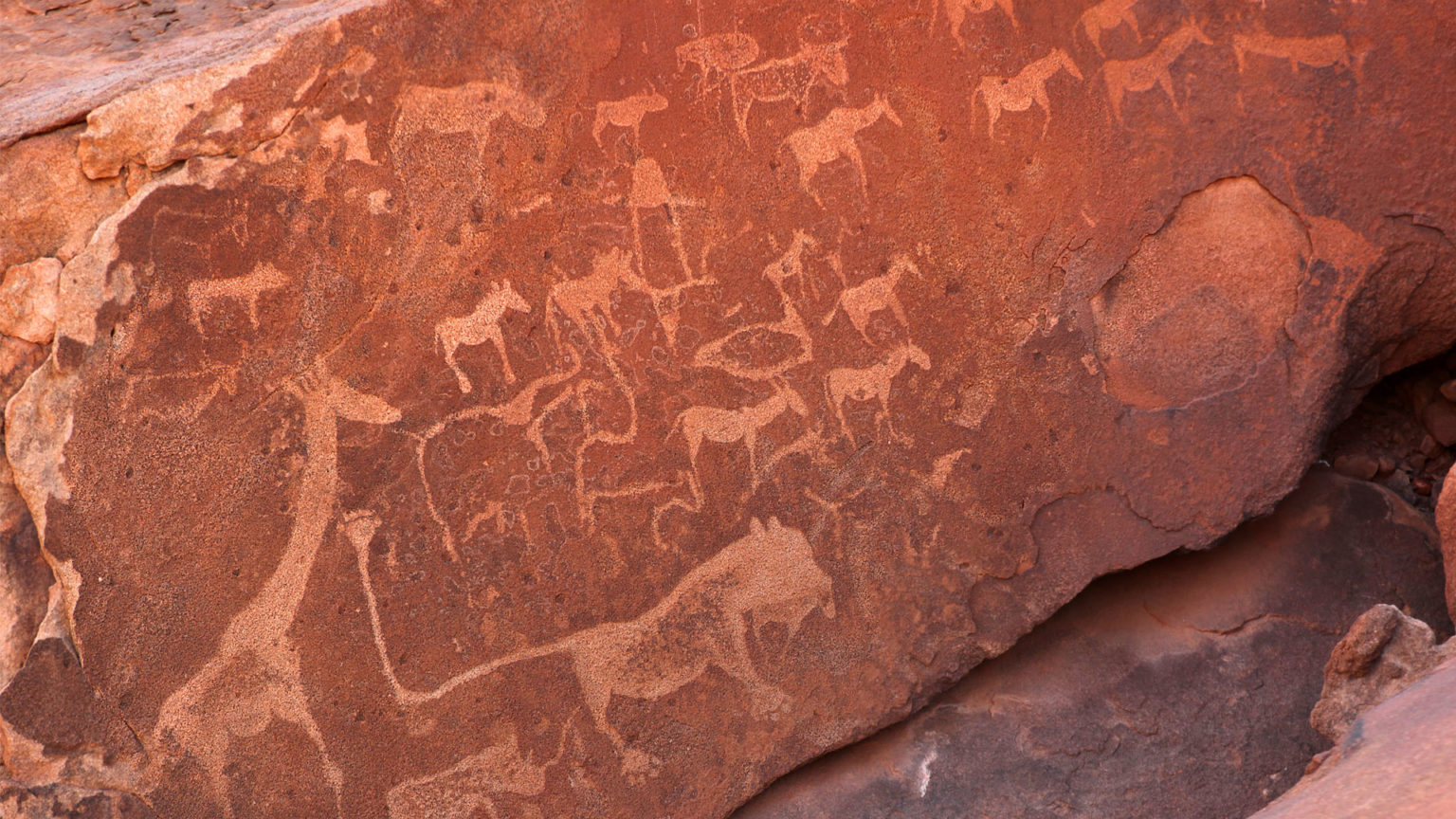Namibia is a country rich in history and culture, home to diverse landscapes, communities, and an array of ancient artifacts that tell the story of its early inhabitants. One of the most fascinating and significant archaeological sites in Namibia is Twyfelfontein, a UNESCO World Heritage Site renowned for its exceptional collection of rock engravings. These petroglyphs, etched into the rocks over thousands of years, offer a glimpse into the lives, beliefs, and customs of the early inhabitants of the region. In this article, we will explore the historical, cultural, and artistic significance of the Twyfelfontein rock engravings, the discovery of this ancient site, and the efforts to preserve these remarkable artworks for future generations.
1. Twyfelfontein: A Brief Overview
Twyfelfontein is located in the Damaraland region of northwestern Namibia, nestled within the Namib Desert, and is considered one of the most important archaeological sites in Africa. The name “Twyfelfontein” means “doubtful spring” in Dutch, referring to a water source in the area that was often unreliable. However, the real treasure of Twyfelfontein is not the water source but the extraordinary collection of rock engravings found throughout the site.
Twyfelfontein is home to more than 5,000 petroglyphs spread across a vast area, making it one of the largest concentrations of rock engravings in Africa. These engravings are believed to date back to between 2,000 and 6,000 years ago, created by early hunter-gatherer societies, specifically the ancestors of the Khoisan people, who are the region’s indigenous inhabitants. The site offers a unique and vivid window into the prehistoric life of Namibia’s people.
2. The Discovery of Twyfelfontein Rock Engravings
The discovery of Twyfelfontein and its rock engravings can be traced back to the early 20th century. In the 1940s, a German geologist, Dr. H. J. van der Merwe, conducted the first survey of the site. He was struck by the numerous carvings he found etched into the rocks, but it wasn’t until 1960, when Dr. Peter Scherzer, an archaeologist, and his team began detailed research, that the site gained international recognition for its significance. Scherzer’s efforts led to the excavation and cataloging of the petroglyphs, which revealed the intricacies of the artwork and its profound cultural and historical significance.
In 2007, Twyfelfontein was designated a UNESCO World Heritage Site due to its exceptional value as a record of early human expression and its importance in understanding the art and lifestyle of prehistoric communities in Southern Africa.
3. Understanding the Rock Engravings
The Twyfelfontein rock engravings provide an extraordinary insight into the lives of Namibia’s early hunter-gatherer societies. The petroglyphs depict a variety of animals, human figures, and geometric patterns that were created through the technique of pecking and scratching the rock surface. The engravings were made using sharp stones or bone tools, and the artists used the natural features of the rocks to enhance their designs.
1. Depictions of Wildlife
One of the most striking features of the Twyfelfontein petroglyphs is the representation of animals. The engravings feature a wide range of wildlife that would have been familiar to the region’s early inhabitants. The animals depicted include:
- Elephants
- Giraffes
- Rhinos
- Lions
- Hartebeests
- Springboks
These depictions of animals are not just artistic representations but are believed to have had spiritual or ritualistic significance. Many of the animals portrayed were integral to the daily life of the people, either as sources of food, clothing, or tools. Furthermore, the engravings may have served as symbols or rituals to ensure successful hunts or to represent totemic beliefs tied to these animals.
2. Human Figures and Rituals
In addition to animals, the Twyfelfontein petroglyphs also feature human figures engaged in various activities. Some of these figures are shown with exaggerated features, such as large heads or distinctive body postures, which may suggest they were symbolic representations rather than realistic depictions.
The human figures are often seen in scenes that suggest rituals, dancing, or ceremonial activities. These images likely represent important cultural practices, including religious rites, social gatherings, or community events. The presence of such figures reflects the deep connection between the people and their environment, as well as their belief systems, which may have involved animal worship, ancestor veneration, or other spiritual practices.
3. Geometric and Abstract Symbols
Alongside the figurative depictions of animals and humans, Twyfelfontein also contains geometric patterns and abstract symbols. These motifs, which include circles, spirals, and parallel lines, are believed to have had symbolic or ritualistic meanings. The abstract nature of these designs suggests that the artists may have been trying to convey ideas beyond the representational — such as cosmological beliefs, spiritual concepts, or stories passed down through generations.
The meanings of these geometric symbols remain largely open to interpretation, but they underscore the depth of the cultural and spiritual world of Namibia’s early peoples. They hint at a complex system of thought and belief that goes beyond mere survival and points to a rich cultural life.
4. The Artistic Significance of the Twyfelfontein Engravings
The rock engravings at Twyfelfontein are considered masterpieces of prehistoric art. They offer a rare and direct connection to the artistic expression of ancient cultures, showcasing the creativity and ingenuity of Namibia’s early inhabitants. The intricate details, the dynamic portrayal of animals, and the combination of naturalistic and abstract elements make Twyfelfontein’s rock engravings a remarkable achievement in the history of human art.
The engravings are not just artistic in nature; they also reveal a deep connection to the environment. The artists’ attention to the behavior of animals, the use of landscape features in the designs, and the symbolic representations of natural forces all point to a sophisticated understanding of the world around them.
5. Cultural and Spiritual Significance
The rock engravings of Twyfelfontein have long been viewed as more than just artistic representations; they are seen as a window into the spiritual and cultural lives of Namibia’s early peoples. The engravings likely served a ritualistic purpose, playing a central role in the social and religious practices of the time. The connection between the art and the environment is crucial, as the engravings appear to reflect a deep reverence for nature and the animals that populated the region.
The site is also a reminder of the spiritual connection that indigenous peoples had with the land. The art reflects not only the animals and people of the time but also the spiritual forces that governed their lives. The engravings may have been used in rituals to ensure good harvests, successful hunts, or protection from malevolent forces.
6. Preservation and Efforts to Protect Twyfelfontein
Given the significance of the Twyfelfontein rock engravings, it is crucial to preserve the site for future generations. The area has faced several threats, including natural erosion, human activity, and the effects of tourism. To protect this cultural heritage, Twyfelfontein was declared a UNESCO World Heritage Site in 2007, ensuring that it is safeguarded from further degradation.
Efforts to protect Twyfelfontein include the establishment of a visitor center and the creation of regulations to minimize the impact of tourism. Guided tours are available, allowing visitors to experience the engravings while learning about their historical and cultural significance. Additionally, researchers and archaeologists continue to study the site to gain a deeper understanding of its role in Namibia’s prehistoric past.
Twyfelfontein stands as a testament to the creativity, spirituality, and resilience of Namibia’s early inhabitants. The rock engravings are not merely artistic expressions; they are a rich cultural heritage that offers invaluable insights into the lives, beliefs, and social structures of ancient societies. Through the discovery and study of Twyfelfontein, we are reminded of the profound connection between art, culture, and the natural world, a connection that continues to resonate with Namibians today.
As we continue to explore and understand the ancient art of Namibia, sites like Twyfelfontein play a crucial role in preserving the country’s history and ensuring that the stories of its early peoples are not forgotten. The rock engravings of Twyfelfontein are not only an essential part of Namibia’s cultural heritage but also a universal reminder of the power of art to transcend time and connect us to our past.













